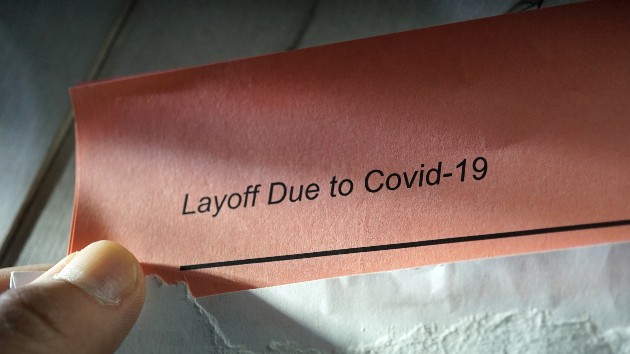
Kameleon007/iStockBy LAYNE WINN, ABC News
(NEW YORK) — Over 38 million Americans have applied for unemployment benefits since the coronavirus outbreak began shutting down the United States economy in mid-March. Major companies such as Uber, Airbnb and United Airlines have laid off thousands of workers and retail corporations have been hit particularly hard. Neiman Marcus, J. Crew and J. C. Penney all filed for bankruptcy amid the global pandemic.
While there are many uncertainties surrounding the state of the U.S. economy and the timeframe businesses will resume normal operation, furloughed and laid-off employees have one thing in common: neither are getting paid.
The following questions and answers can help you understand the two forms of unemployment and how to move forward:
What is a furlough?
A furlough is an unpaid leave of absence. Most of the time, furloughs are used for a company that is financially struggling to cut costs for a period hoping to bring the employee back when that period passes.
A layoff is when your relationship with your employer is terminated. If you are laid off, you receive no further compensation or benefits from your employer.
“With a furlough, employees are still active employees on the payroll whereas with a layoff, they’re actually separated from the payroll,” said Amber Clayton, Knowledge Center director at Society for Human Resource Management.
The hospitality industry has undoubtedly been hit hard with layoffs during the outbreak, but no industry seems to be safe with thousands of layoffs occurring in state and local governments and even among health care workers, according to the Bureau of Labor Statistics.
Why would companies furlough instead of layoff workers?
When employers furlough workers, they avoid some administrative processes involved in terminating an employee, according to Clayton.
There’s normally no severance package provided with a furlough as with a layoff. Plus, employees are usually more willing to stay engaged with the company if they think there’s a chance they can come back to work.
“Employees tend to stay more engaged when furloughed, because they know that this is temporary and that the employer is going to have them come back into their regular positions,” Clayton said. “It’s less likely that they’re going to go and try to find other employment.”
How long can you be furloughed?
There is no time limit to a furlough — it could last a few weeks or even months.
It’s best to stay in contact with your employer while furloughed so you are up to date on the company’s plans for bringing you back.
Can you keep your health insurance if furloughed?
A benefit of being furloughed rather than laid off is in many cases, you can keep your health insurance with the company as long as you are still making payments.
“Some employers have worked with their health insurance carriers to provide a plan that actually allows for someone to take an unpaid leave of absence and still continue their insurance during that period,” Clayton said.
Furloughed workers should always look at their employer’s plan to determine whether health insurance can continue.
However, laid-off workers are typically offered Consolidated Omnibus Budget Reconciliation Act benefits, which provides a continuation of coverage for terminated workers. Through COBRA, most people can keep their insurance for up to 18 months. Laid-off employees must apply for COBRA through their state’s health plan marketplace.
Can you keep your benefits?
Some companies will allow furloughed workers to keep their benefits, such as vacation or paid time off during their leave of absence.
Some states require employers pay out paid time off to laid-off workers. Any furloughed or laid-off workers should check with their employer to see what they are eligible for.
Regarding a 401(k), if an employee is not receiving a paycheck, they generally wouldn’t be able to contribute to their plan. Furloughed workers can increase contributions when they are back at work and should check with their employer to see if they can continue matching contributions during the furlough.
“Employees may decide after they return that they want to increase their contributions to make up for that loss, for those weeks or months they were on furlough or being laid off,” Clayton said.
If you are laid off, you have the right to move the money in your 401(k) into an individual retirement account without paying income taxes on it. You will have to coordinate this rollover between your former employer and the mutual fund, bank or brokerage that will oversee your IRA.
Can you collect unemployment?
Both part-time and full-time furloughed workers or those laid off are eligible to collect unemployment benefits in most cases.
In 2019, the national average unemployment payment was $371.88 a week, but because of the coronavirus outbreak and the mass number of workers who have had to file for unemployment, the federal government is adding $600 to weekly benefits until July 31 under the CARES Act.
Each state varies on how to apply for unemployment and how long claimants receive benefits, with a majority of states offering benefits for 26 weeks. However, under the Pandemic Emergency Unemployment Compensation program, workers can qualify for an additional 13 weeks of benefits on top of their state coverage.
Sixty-eight percent of unemployed workers are eligible for a weekly benefits check that is higher than their former income, according to a study from the University of Chicago.
Is it guaranteed you will get your job back if you’re furloughed?
As the country begins to reopen, there is no guarantee that furloughed workers will be brought back as a company could issue a “reduction in force,” said Clayton, leaving the employee permanently laid off.
Copyright © 2020, ABC Audio. All rights reserved.
